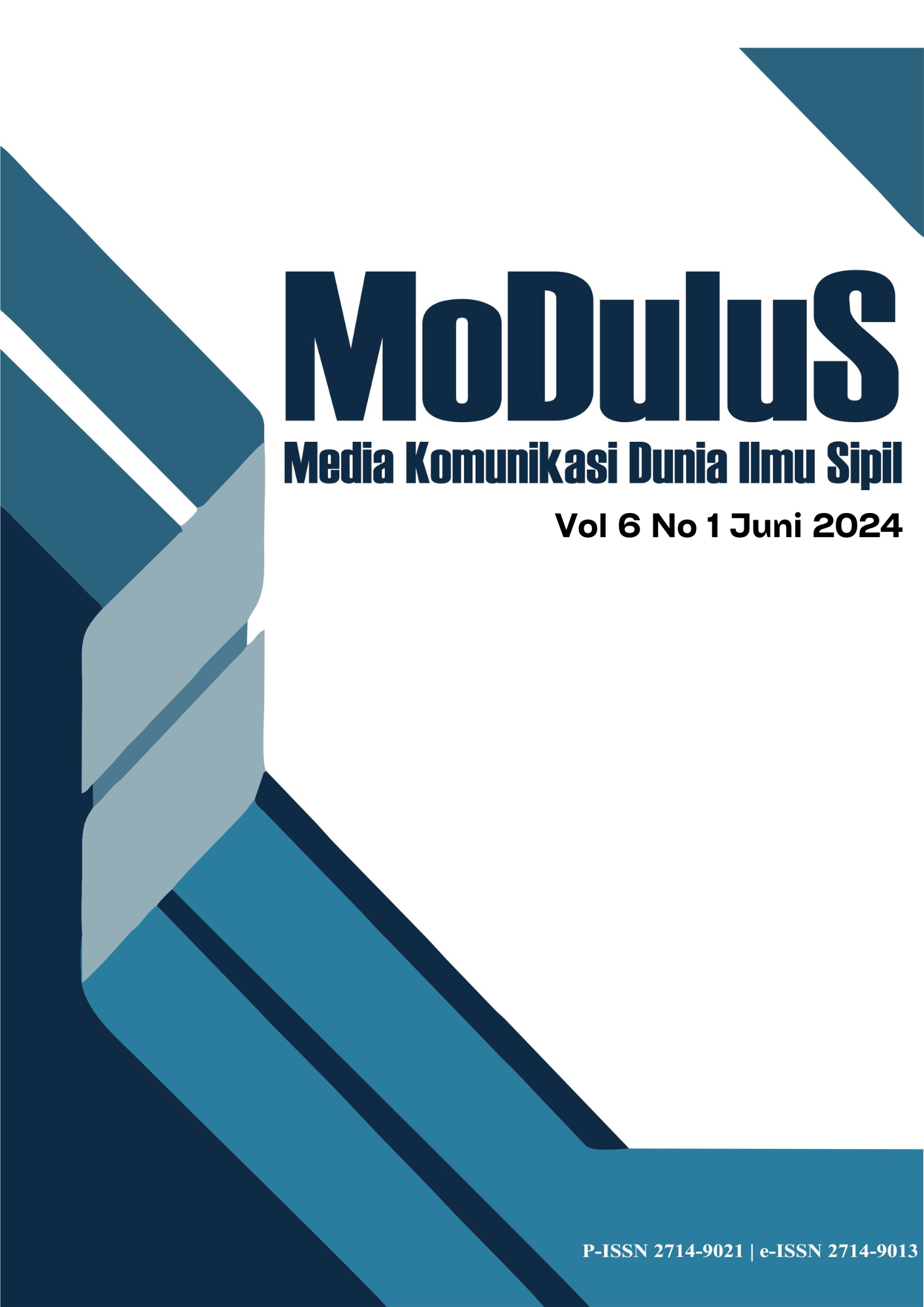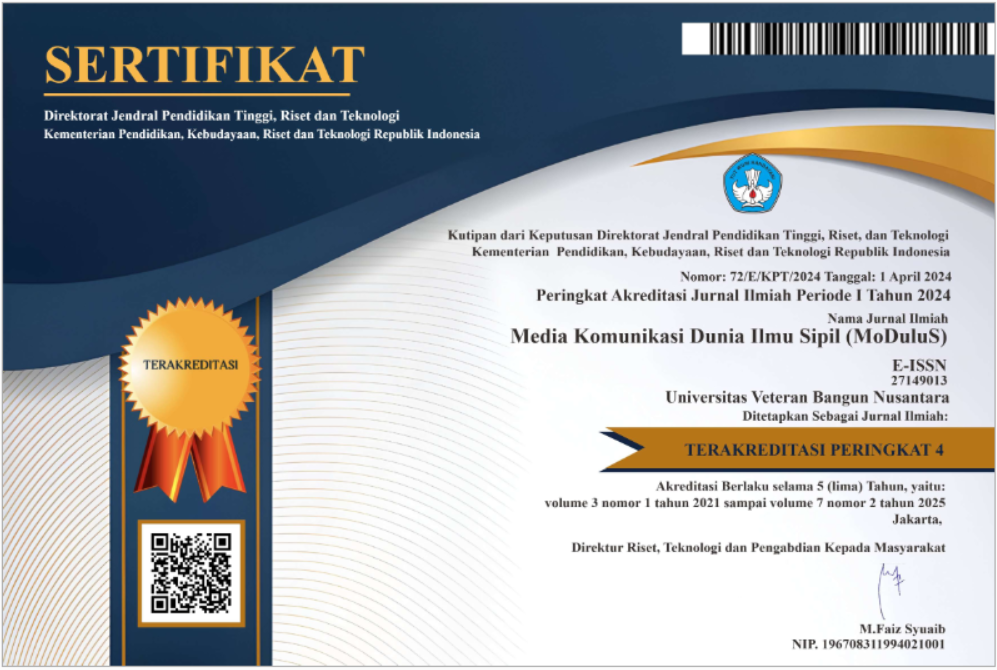Penggunaan Metode Artificial Neural Network dalam Pembuatan Peta Kerentanan Longsor Wilayah Kabupaten Karanganyar
DOI:
https://doi.org/10.32585/modulus.v6i1.4493Kata Kunci:
Artificial Neural Network (ANN), Peta Kerentanan Longsor, Ten-folds cross validationAbstrak
Tanah longsor menjadi bencana alam yang marak terjadi di Indonesia. Selama sepuluh tahun terakhir terdapat 2975 kejadian tanah longsor yang terjadi di Jawa Tengah, di mana 101 kejadian tanah longsor berada di Kabupaten Karanganyar. Penelitian ini bertujuan untuk membuat peta kerentanan longsor pada wilayah Kabupaten Karanganyar. Peta kerentanan akan dibagi menjadi lima kelas, yaitu sangat rendah, rendah, sedang, tinggi dan sangat tinggi dengan menggunakan metode natural breaks (jenk’s). Penelitian ini menggunakan 9 faktor pengondisi longsor yaitu jarak terhadap jalan sekunder, jarak terhadap jalan tersier, slope, topographic wetness index (TWI), elevasi, tata guna lahan (landuse), litologi, normalized difference vegetation index (NDVI), dan hujan. Pembuatan peta dilakukan dengan menggunakan Artificial Neural Network dengan bantuan modul scikit learn dan metode ten-folds cross validation digunakan sebagai metode validasi model yang dihasilkan. Nilai landslide density dihitung pada penelitian ini untuk evaluasi performa dari hasil klasifikasi kerentanan longsor. Parameter machine learning yang digunakan pada penelitian ini adalah hidden layer sizes, activation, maximum iteration dan random state. Performa model Artificial Neural Network yang dihasilkan menggunakan parameter tersebut menunjukkan hasil yang excellent. Nilai AUC yang didapat pada penelitian ini sebesar 0,9140 dengan nilai ten-folds cross validation 0,7444.
Unduhan
Referensi
Akinci, H. (2022). Assessment of rainfall-induced landslide susceptibility in Artvin, Turkey using machine learning techniques. Journal of African Earth Sciences, 191(April), 104535. https://doi.org/10.1016/j.jafrearsci.2022.104535
BNPB. (2023). Geoportal Data Bencana Indone-sia. https://gis.bnpb.go.id/
Bre, F., Gimenez, J. M., & Fachinotti, V. D. (2018). Prediction of wind pressure coeffi-cients on building surfaces using artificial neural networks. Energy and Buildings, 158, 1429–1441. https://doi.org/10.1016/j.enbuild.2017.11.045
Chen, J., Yang, S., Li, H., Zhang, B., & Lv, J. (2013). Research on geographical envi-ronment unit division based on the method of natural breaks (Jenks). International Ar-chives of the Photogrammetry, Remote Sensing and Spatial Information Sciences - ISPRS Archives, 40(4W3), 47–50. https://doi.org/10.5194/isprsarchives-XL-4-W3-47-2013
Chen, W., Pourghasemi, H. R., Kornejady, A., & Zhang, N. (2017). Landslide spatial model-ing: Introducing new ensembles of ANN, MaxEnt, and SVM machine learning tech-niques. Geoderma, 305, 314–327. https://doi.org/10.1016/J.GEODERMA.2017.06.020
Dastres, R., & Soori, M. (2021). Artificial Neural Network Systems. International Journal of Imaging and Robotics, 21(2). https://www.researchgate.net/publication/350486076_Artificial_Neural_Network_Systems
Fitria, I. (2021). Eliminasi Faktor pada Model Pemetaan Risiko Kerentaan Longsor Ber-basis Sistem Kecerdasan Buatan. Universi-tas Sebelas Maret.
Hammad Khaliq, A., Basharat, M., Talha Riaz, M., Tayyib Riaz, M., Wani, S., Al-Ansari, N., Ba Le, L., & Thi Thuy Linh, N. (2022). Spatiotemporal landslide susceptibility mapping using machine learning models: A case study from district Hattian Bala, NW Himalaya, Pakistan. Ain Shams Engineer-ing Journal, xxxx, 101907. https://doi.org/10.1016/j.asej.2022.101907
He, Q., Shahabi, H., Shirzadi, A., Li, S., Chen, W., Wang, N., Chai, H., Bian, H., Ma, J., Chen, Y., Wang, X., Chapi, K., & Ahmad, B. Bin. (2019). Landslide spatial modelling using novel bivariate statistical based Naïve Bayes, RBF Classifier, and RBF Network machine learning algorithms. Science of the Total Environment, 663, 1–15. https://doi.org/10.1016/j.scitotenv.2019.01.329
Liao, M., Wen, H., & Yang, L. (2022). Identifying the essential conditioning factors of land-slide susceptibility models under different grid resolutions using hybrid machine learning: A case of Wushan and Wuxi counties, China. Catena, 217(October 2021), 106428. https://doi.org/10.1016/j.catena.2022.106428
Marzuki, T. (2021). PEMBUATAN SCRIPT PEMETAAN WILAYAH RESIKO KERENTANAN LONGSOR BERBASIS SISTEM KECERDASAN BUATAN. Universi-tas Sebelas Maret.
Meinhardt, M., Fink, M., & Tünschel, H. (2015). Landslide susceptibility analysis in central Vietnam based on an incomplete landslide inventory: Comparison of a new method to calculate weighting factors by means of bi-variate statistics. Geomorphology, 234, 80–97. https://doi.org/10.1016/j.geomorph.2014.12.042
Merghadi, A., Yunus, A. P., Dou, J., Whiteley, J., ThaiPham, B., Bui, D. T., Avtar, R., & Ab-derrahmane, B. (2020). Machine learning methods for landslide susceptibility stud-ies: A comparative overview of algorithm performance. Earth-Science Reviews, 207(September 2019), 103225. https://doi.org/10.1016/j.earscirev.2020.103225
NASA. (2013). Earthdata Search | Earthdata Search. https://search.earthdata.nasa.gov/search
NASA. (2020). GES DISC. https://disc.gsfc.nasa.gov/
NASA. (2022). MODIS Web. https://modis.gsfc.nasa.gov/
Ortiz, J. A. V., & Martínez-Graña, A. M. (2018). A neural network model applied to land-slide susceptibility analysis (Capitanejo, Colombia). Geomatics, Natural Hazards and Risk, 9(1), 1106–1128. https://doi.org/10.1080/19475705.2018.1513083
Pascale, S., Parisi, S., Mancini, A., Schiattarella, M., Conforti, M., Sole, A., Murgante, B., & Sdao, F. (2013). Landslide susceptibility mapping using artificial neural network in the urban area of Senise and San Costanti-no Albanese (Basilicata, Southern Italy). Lecture Notes in Computer Science (in-cluding subseries Lecture Notes in Artifi-cial Intelligence and Lecture Notes in Bio-informatics), 7974 LNCS(PART 4), 473–488. https://doi.org/10.1007/978-3-642-39649-6_34
Pham, B. T., Pradhan, B., Tien Bui, D., Prakash, I., & Dholakia, M. B. (2016). A comparative study of different machine learning meth-ods for landslide susceptibility assessment: A case study of Uttarakhand area (India). Environmental Modelling and Software, 84, 240–250. https://doi.org/10.1016/j.envsoft.2016.07.005
Priyono, K. D., Jumadi, Saputra, A., & Fikriyah, V. N. (2020). Risk analysis of landslide impacts on settlements in Karanganyar, Central Java, Indonesia. International Journal of GEOMATE, 19(73), 100–107. https://doi.org/10.21660/2020.73.34128
PT. Indonesia Geospasial Tech. (2020). √ Down-load Shapefile Geologi Seluruh Indonesia - INDONESIA GEOSPASIAL. https://www.indonesia-geospasial.com/2020/03/download-data-shapefile-shp-geologi-se.html
Selamat, S. N., Majid, N. A., Taha, M. R., & Os-man, A. (2022). Landslide Susceptibility Model Using Artificial Neural Network (ANN) Approach in Langat River Basin, Selangor, Malaysia. Land, 11(6). https://doi.org/10.3390/land11060833
Sharifi Teshnizi, E., Golian, M., Sadeghi, S., & Rastegarnia, A. (2022). Application of ana-lytical hierarchy process (AHP) in land-slide susceptibility mapping for Qazvin province, N Iran. Computers in Earth and Environmental Sciences, 55–95. https://doi.org/10.1016/B978-0-323-89861-4.00041-5
Sun, D., Gu, Q., Wen, H., Xu, J., Zhang, Y., Shi, S., Xue, M., & Zhou, X. (2022). Assessment of landslide susceptibility along mountain highways based on different machine learning algorithms and mapping units by hybrid factors screening and sample opti-mization. Gondwana Research, xxxx. https://doi.org/10.1016/j.gr.2022.07.013
Youssef, A. M., & Pourghasemi, H. R. (2021). Landslide susceptibility mapping using machine learning algorithms and compari-son of their performance at Abha Basin, Asir Region, Saudi Arabia. Geoscience Frontiers, 12(2), 639–655. https://doi.org/10.1016/j.gsf.2020.05.010
Zhao, L., Liu, M., Song, Z., Wang, S., Zhao, Z., & Zuo, S. (2022). Regional-scale modeling of rainfall-induced landslides under random rainfall patterns. Environmental Modelling and Software, 155(February), 105454. https://doi.org/10.1016/j.envsoft.2022.105454
Zhou, X., Wen, H., Zhang, Y., Xu, J., & Zhang, W. (2021). Landslide susceptibility mapping using hybrid random forest with GeoDetec-tor and RFE for factor optimization. Geo-science Frontiers, 12(5), 101211. https://doi.org/10.1016/j.gsf.2021.101211
Unduhan
Diterbitkan
Terbitan
Bagian
Lisensi
Hak Cipta (c) 2024 Atilla Salwa, Raden Harya Dananjaya, Niken Silmi Surjandari

Artikel ini berlisensiCreative Commons Attribution-NonCommercial-ShareAlike 4.0 International License.
This work is licensed under a Creative Commons Attribution-NonCommercial 4.0 International License.














